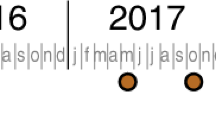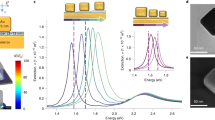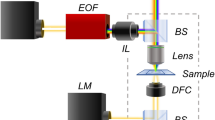Abstract
The physical properties of metals change when their dimensions are reduced to the nano-scale and new phenomena such as the localized surface-plasmon resonance (LSPR) appear. This collective electronic excitation can be tuned over a large spectral range by adapting the material, size and shape. The existing literature is as rich as it is controversial—for example, size-dependent spectral shifts of the LSPR in small metal nanoparticles, induced by quantum effects, are reported to the red, to the blue or entirely absent. Here we report how complementary experiments on size-selected small silver nanoparticles embedded in silica can yield inconsistent results on the same system: whereas optical absorption shows no size effect in the range between only a few atoms and ~10 nm, a clear spectral shift is observed in single-particle electron spectroscopy. Our quantitative interpretation, based on a mixed classical/quantum model, resolves the apparent contradictions, not only within our experimental data, but also in the literature. Our comprehensive model describes how the local environment is the crucial parameter controlling the manifestation or absence of quantum size effects.
This is a preview of subscription content, access via your institution
Access options
Access Nature and 54 other Nature Portfolio journals
Get Nature+, our best-value online-access subscription
$29.99 / 30 days
cancel any time
Subscribe to this journal
Receive 12 print issues and online access
$209.00 per year
only $17.42 per issue
Buy this article
- Purchase on Springer Link
- Instant access to full article PDF
Prices may be subject to local taxes which are calculated during checkout






Similar content being viewed by others
Data availability
The data that support the plots within this paper and other findings of this study are available from the corresponding author upon reasonable request.
References
Ekardt, W. (ed.) Metal clusters (Wiley, Hoboken, 1999).
Heiz, U. & Landman, U. E. (eds.) Nanocatalysis (Springer, Heidelberg, Berlin, 2007).
Odom, T. W. & Schatz, G. C. Introduction to plasmonics. Chem. Rev. 111, 3667–3668 (2011).
Anker, J. N. et al. Biosensing with plasmonic nanosensors. Nat. Mater. 7, 442–453 (2008).
Kreibig, U. & Vollmer, M. Optical properties of Metal Clusters (Springer, Berlin, 1995).
Billaud, P. et al. Absolute optical extinction measurements of single nano-objects by spatial modulation spectroscopy using a white lamp. Rev. Sci. Instrum. 81, 043101 (2010).
Celebrano, M., Kukura, P., Renn, A. & Sandoghdar, V. Single-molecule imaging by optical absorption. Nat. Photon. 5, 95–98 (2011).
Ringe, E., Sharma, B., Henry, A.-I., Marks, L. D. & Van Duyne, R. P. Single nanoparticle plasmonics. Phys. Chem. Chem. Phys. 15, 4110–4129 (2013).
Kociak, M. & Stéphan, O. Mapping plasmons at the nanometer scale in an electron microscope. Chem. Soc. Rev. 43, 3865–3883 (2014).
Colliex, C., Kociak, M. & Stéphan, O. Electron energy loss spectroscopy imaging of surface plasmons at the nanometer scale. Ultramicroscopy 162, A1–A24 (2016).
Rossouw, D., Couillard, M., Vickery, J., Kumacheva, E. & Botton, G. A. Multipolar plasmonic resonances in silver nanowire antennas imaged with a subnanometer electron probe. Nano. Lett. 11, 1499–1504 (2011).
Ögüt, B., Talebi, N., Vogelgesang, R., Sigle, W. & van Aken, P. A. Toroidal plasmonic eigenmodes in oligomer nanocavities for the visible. Nano. Lett. 12, 5239–5244 (2012).
Bosman, M. et al. Surface plasmon damping quantified with an electron nanoprobe. Sci. Rep. 3, 1312 (2013).
Hörl, A. et al. Tomographic imaging of the photonic environment of plasmonic nanoparticles. Nat. Commun. 8, 37 (2017).
Losquin, A. et al. Unveiling nanometer scale extinction and scattering phenomena through combined electron energy loss spectroscopy and cathodoluminescence measurements. Nano. Lett. 15, 1229–1237 (2015).
Scholl, J. A., Koh, A. L. & Dionne, J. A. Quantum plasmon resonances of individual metallic nanoparticles. Nature 483, 421–428 (2012).
Raza, S. et al. Blueshift of the surface plasmon resonance in silver nanoparticles studied with EELS. Nanophotonics 2, 131–138 (2013).
Haberland, H. Looking from both sides. Nature 494, E1–E2 (2013).
Tiggesbäumker, J., Köller, L., Meiwes-Broer, K.-H. & Liebsch, A. Blue shift of the Mie plasma frequency in Ag clusters and particles. Phys. Rev. A 48, R1749–R1752 (1993).
Hilger, A., Cüppers, N., Tenfelde, M. & Kreibig, U. Surface and interface effects in the optical properties of silver nanoparticles. Eur. Phys. J. D 10, 115–118 (2000).
Hillenkamp, M., Di Domenicantonio, G., Eugster, O. & Félix, C. Instability of Ag nanoparticles in SiO2 at ambient conditions. Nanotechnology. 18, 015702 (2007).
Cottancin, E, Broyer, M, Lermé, J. & Pellarin, M. in Handbook of Nanophysics: Nanoelectronics and Nanophotonics (ed. Sattler, K. A.) Ch. 24 (CRC Press, Boca Raton, 2011).
Mortensen, N. A., Raza, S., Wubs, M., Søndergaard, T. & Bozhevolnyi, S. I. A generalized non-local optical response theory for plasmonic nanostructures. Nat. Commun. 5, 3809 (2014).
Christensen, T. et al. Nonlocal response of metallic nanospheres probed by light, electrons, and atoms. ACS Nano 8, 1745–1758 (2014).
Raza, S. et al. Multipole plasmons and their disappearance in few-nanometre silver nanoparticles. Nat. Commun. 6, 8788 (2015).
Liebsch, A. Surface-plasmon dispersion and size dependence of Mie resonance: Silver versus simple metals. Phys. Rev. B 48, 11317–11328 (1993).
Bréchignac, C., Cahuzac, P., Leygnier, J. & Sarfati, A. Optical response of large lithium clusters: Evolution toward the bulk. Phys. Rev. Lett. 70, 2036–2039 (1993).
Toscano, G. et al. Resonance shifts and spill-out effects in self-consistent hydrodynamic nanoplasmonics. Nat. Commun. 6, 7132 (2015).
Monreal, R. C., Antosiewicz, T. J. & Apell, S. P. Competition between surface screening and size quantization for surface plasmons in nanoparticles. New J. Phys. 15, 083044 (2013).
Lermé, J. et al. Quenching of the size effects in free and matrix-embedded silver clusters. Phys. Rev. Lett. 80, 5105–5108 (1998).
Kasperovich, V. & Kresin, V. V. Ultraviolet photoabsorption spectra of silver and gold nanoclusters. Phil. Mag. 78, 385–396 (1998).
Genzel, L., Martin, T. P. & Kreibig, U. Dielectric function and plasma resonances of small metal particles. Z. Phys. B 21, 339–346 (1975).
Charlé, K.-P., König, L., Nepijko, S., Rabin, I. & Schulze, W. The surface plasmon resonance of free and embedded Ag-clusters in the size range 1.5 nm < D < 30 nm. Cryst. Res. Technol. 33, 1085–1096 (1998).
Nilius, N., Ernst, N. & Freund, H.-J. Photon emission spectroscopy of individual oxide-supported silver clusters in a scanning tunneling microscope. Phys. Rev. Lett. 84, 3994–3997 (2000).
Lünskens, T. et al. Plasmons in supported size-selected silver nanoclusters. Phys. Chem. Chem. Phys. 17, 17541–17544 (2015).
Peng, S., McMahon, J. M., Schatz, G. C., Gray, S. K. & Sun, Y. Reversing the size-dependence of surface plasmon resonances. Proc. Natl Acad. Sci. USA 107, 14530–14534 (2010).
Raza, S., Yan, W., Stenger, N., Wubs, M. & Mortensen, N. A. Blueshift of the surface plasmon resonance in silver nanoparticles: substrate effects. Opt. Express 21, 27344–27355 (2013).
Koh, A. L. et al. Electron energy-loss spectroscopy (EELS) of surface plasmons in single silver nanoparticles and dimers: influence of beam damage and mapping of dark modes. ACS Nano 3, 3015–3022 (2009).
Fedrigo, S., Harbich, W. & Buttet, J. Collective dipole oscillations in small silver clusters embedded in rare-gas matrices. Phys. Rev. B 47, 10706–10715 (1993).
Lecoultre, S. et al. Ultraviolet-visible absorption of small silver clusters in neon: Agn (n = 1–9). J. Chem. Phys. 134, 184504 (2011).
Kreibig, U. Small silver particles in photosensitive glass: Their nucleation and growth. Appl. Phys. 10, 255–264 (1976).
Cottancin, E. et al. Optical properties of noble metal clusters as a function of the size: comparison between experiments and a semi-quantal theory. Theor. Chem. Acc. 116, 514–523 (2006).
Sachan, R. et al. Oxidation-resistant silver nanostructures for ultrastable plasmonic applications. Adv. Mater. 25, 2045–2050 (2013).
Römer, I., Wang, Z. W., Merrifield, R. C., Palmer, R. E. & Lead, J. High resolution STEM-EELS study of silver nanoparticles exposed to light and humic substances. Environ. Sci. Technol. 50, 2183–2190 (2016).
Lermé, J. et al. Quantum extension of Mie’s theory in the dipolar approximation. Phys. Rev. B 60, 16151–16156 (1999).
Lermé, J. Optical properties of gold metal clusters: A time-dependent local-density-approximation investigation. Eur. Phys. J. D 10, 265–277 (2000).
Brack, M. The physics of simple metal clusters: self-consistent jellium model and semiclassical approaches. Rev. Mod. Phys. 65, 677–732 (1993).
de Heer, W. A. The physics of simple metal clusters: experimental aspects and simple models. Rev. Mod. Phys. 65, 611–676 (1993).
Johnson, P. B. & Christy, R. W. Optical constants of the noble metals. Phys. Rev. B 6, 4370–4379 (1972).
Pérez, A. et al. Nanostructured materials from clusters: synthesis and properties. Mater. Trans. 42, 1460–1470 (2001).
Hillenkamp, M., Di Domenicantonio, G. & Félix, C. Monodispersed metal clusters in solid matrices: A new experimental setup. Rev. Sci. Instrum. 77, 025104 (2006).
Haberland, H. et al. Filling of micron-sized contact holes with copper by energetic cluster impact. J. Vac. Sci. Technol. A 12, 2925–2930 (1994).
Bromann, K. et al. Controlled deposition of size-selected silver nanoclusters. Science 274, 956–958 (1996).
HyperSpy 1.0 (Zenodo, 2016); https://doi.org/10.5281/zenodo.57882
Acknowledgements
We acknowledge financial support from the French National Research Agency (Agence Nationale de Recherche, ANR) in the frame of the project ‘FIT SPRINGS’, ANR-14-CE08-0009. This work has received support from the National Agency for Research under the programme of future investment TEMPOSCHROMATEM with the Reference Number ANR-10-EQPX-50. This work was performed using the Lyon Cluster Research Platform PLYRA. M.H. acknowledges support from the Brazilian Science Without Borders ‘Special Visiting Scientist’ programme (88881.030488/2013-01), and from the São Paulo Research Foundation (FAPESP, 16/12807-4). We gratefully acknowledge technical support from O. Boisron, C. Albin and C. Clavier and fruitful discussions with D. Ugarte.
Author information
Authors and Affiliations
Contributions
H.-C.W., M.K. and M.H. designed the project; N.T., E.C., M.P. and M.H. fabricated the samples and performed optical spectroscopy; A.C. and M.K. performed STEM-EELS experiments, treated the data and developed the corresponding theoretical description; J.L. developed the theoretical model of the optical response and its equivalence to EELS and performed the calculations; M.H. coordinated the data interpretation and wrote the manuscript; all authors participated in the discussion.
Corresponding author
Ethics declarations
Competing interests
The authors declare no competing interests.
Additional information
Publisher’s note: Springer Nature remains neutral with regard to jurisdictional claims in published maps and institutional affiliations.
Supplementary information
Supplementary Information
3 chapters, 19 figures, 64 references, 64 equations
Rights and permissions
About this article
Cite this article
Campos, A., Troc, N., Cottancin, E. et al. Plasmonic quantum size effects in silver nanoparticles are dominated by interfaces and local environments. Nat. Phys. 15, 275–280 (2019). https://doi.org/10.1038/s41567-018-0345-z
Received:
Accepted:
Published:
Issue Date:
DOI: https://doi.org/10.1038/s41567-018-0345-z
This article is cited by
-
Ultra-Fast All-Optical Plasmonic Dual-Band Nonlinear Off–On and Two-Port Switches
Plasmonics (2024)
-
Vanadium Dichalcogenides Triangular Nanoflakes: A Comparative Study of Optical and Electronic Properties
Plasmonics (2024)
-
Toxic Ag+ detection based on Au@Ag core shell nanostructure formation using Tannic acid assisted synthesis of Pullulan stabilized gold nanoparticles
Scientific Reports (2023)
-
Modulation of microstructure and optical properties of anti-reflection HfO2 films by sputtering power and O2/Ar flow ratio
Applied Physics B (2023)
-
Nanosilver anchored alginate/poly(acrylic acid/acrylamide) double-network hydrogel composites for efficient catalytic degradation of organic dyes
Frontiers of Chemical Science and Engineering (2023)



